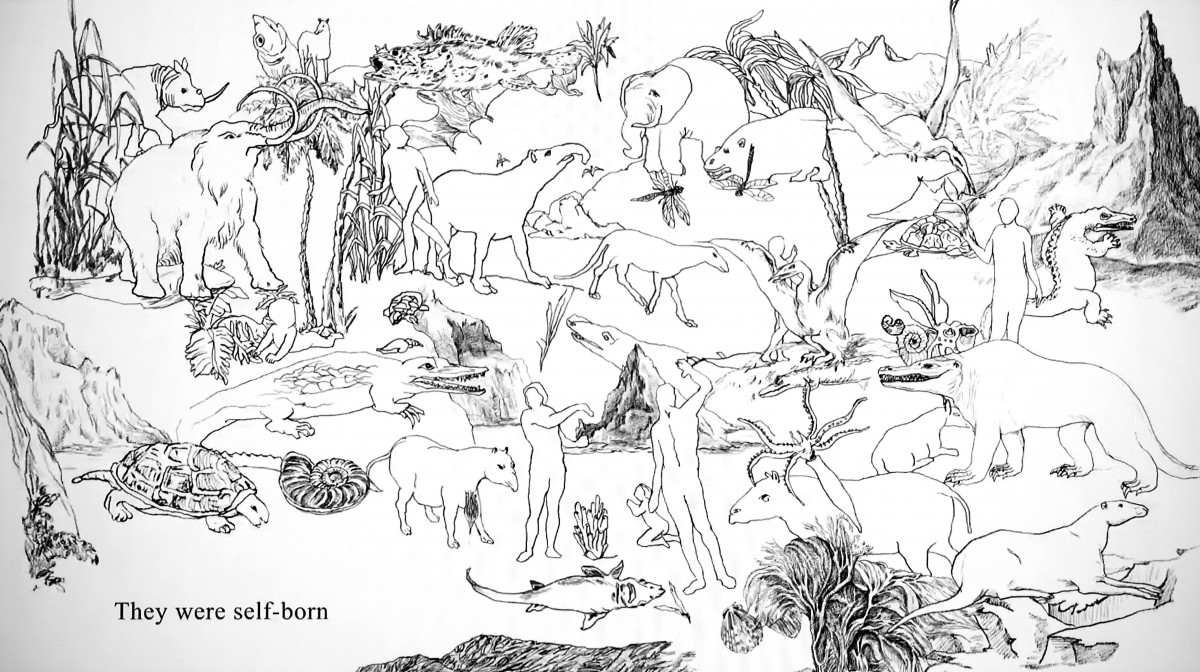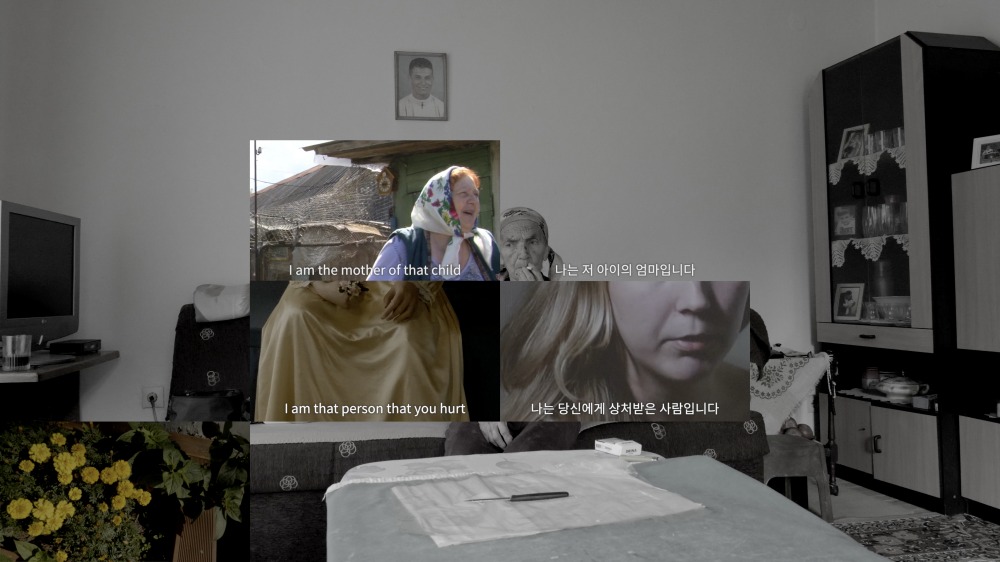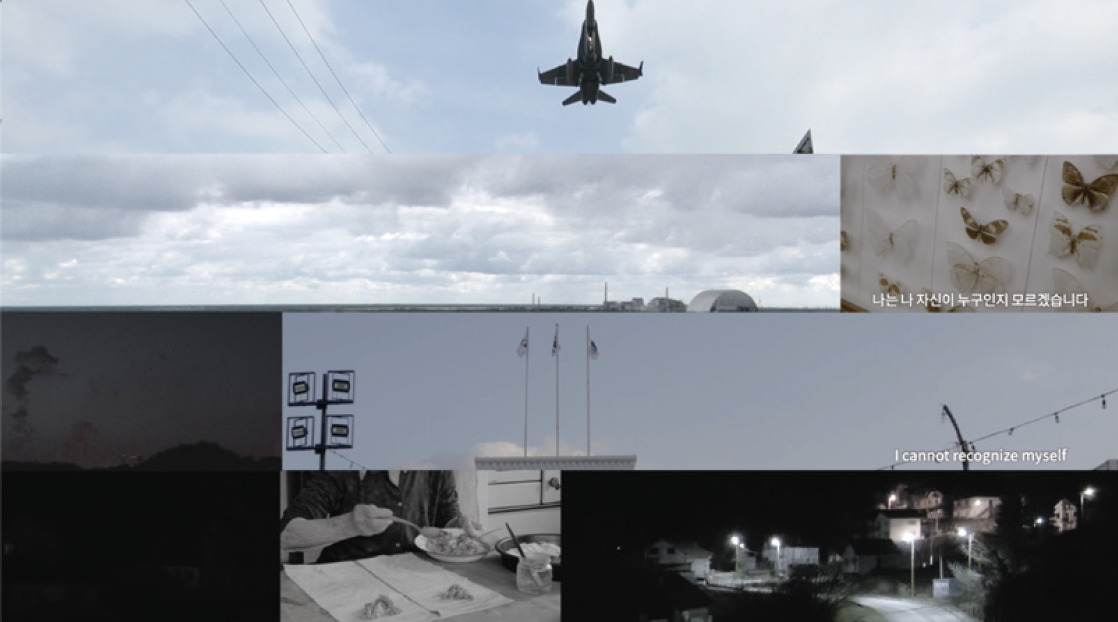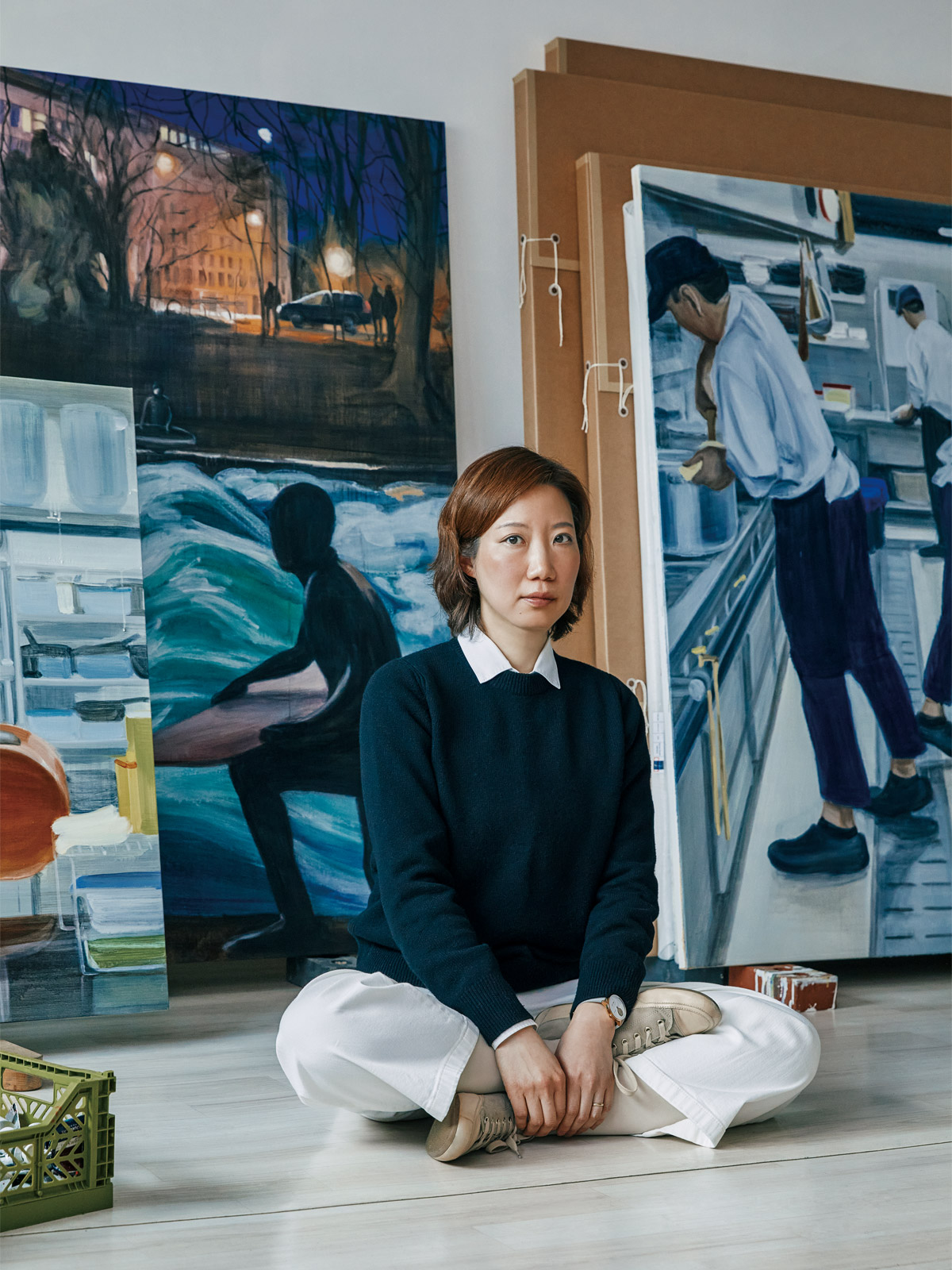Sanghee Song
(b. 1970) has been dedicated to summoning the "nameless beings"
forgotten within the power structures of a society riddled with
contradictions—marked by disaster, terrorism, and war. Based on meticulous
research, the artist constructs multilayered narratives expressed through
various media, including music, video, drawing, text, and performance.
Through
this approach, Song has become known for her work that uncovers and brings to
light the traces and histories of these invisible beings, reviving them in
evocative and sensory forms.

Sanghee Song, Dongducheon, 2005 ©SeMA
Sanghee
Song’s work in the 2000s reimagines the oppressed images of women within a
male-dominated society, using performance and photography to bring to the
surface the overlooked women and their tragic histories.
For
instance, Dongducheon (2005) is a photographic work that
captures the artist standing in the heart of Dongducheon’s red-light district
in Gyeonggi Province, her eyes and mouth covered with black tape. Once an
ordinary town, Dongducheon underwent a drastic transformation following the
Korean War as it became home to a U.S. military base, altering its environment
and living conditions. In the U.S. military camp towns, the government encouraged
prostitution for American soldiers, leading to the oppression and exploitation
of women.
In
Dongducheon, the artist embodies one of the women from the
U.S. military camp town, forced into isolation as a social underdog by enforced
silence, thus crafting a subversive gaze on this overlooked history.
 Sanghee Song, The
Sixteenth Book of Metamorphoses, 2008 ©Sanghee Song
Sanghee Song, The
Sixteenth Book of Metamorphoses, 2008 ©Sanghee SongSong has also explored the tragedies of
reality by weaving them with fictional narratives, such as folktales or myths,
to bring hidden issues to light. A representative work in this vein is her
animated piece, The Sixteenth Book of Metamorphoses (2008),
which interlaces the themes of Ovid’s epic poem
Metamorphoses with contemporary stories.
As a continuation of the original 15 books
of Metamorphoses, The Sixteenth Book of
Metamorphoses depicts a love story among beings that self-generated
at the dawn of time—humanoid creatures called "Khora," a dinosaur
named "Plesiosaurus," and a "Leviathan," the ancestor of
whales. However, as humanity’s greed for oil resources intensifies, the
ecosystem is gradually destroyed, ending with a foreboding warning that hints
at a revenge against humankind.
Connecting her own myth to real events,
Song links The Sixteenth Book of Metamorphoses to her video
work The Road to Mohang, which draws on the real-life
tragedy of the December 2007 Samsung Heavy Industries oil spill. This linkage
transforms the myth of ecological destruction by human greed into a present-day
tragedy, making the fictional devastation of the ecosystem an urgent reflection
on reality.
 Sanghee Song, The
Story of Byeongangsoe 2015: In Search of Humanity, 2015, Installation
view at “Aichi Triennale 2016” ©Aichi Triennale
Sanghee Song, The
Story of Byeongangsoe 2015: In Search of Humanity, 2015, Installation
view at “Aichi Triennale 2016” ©Aichi TriennaleSanghee
Song’s work, which merges human tragedies like environmental destruction,
extinction, and war with fictional narratives, evolved in the 2010s into
complex installations that incorporate text, music, video, and drawings. These
elements are intricately layered based on carefully researched and collected
historical records.
In
The Story of Byeongangsoe 2015: In Search of Humanity
(2015), for instance, the artist visited sites marked by historical tragedies,
projecting drawings of prisoners of war, massacre and disaster victims, and
comfort women. These projected images are interwoven with unsettling text
fragments sourced from various novels, adding a haunting narrative dimension to
the video and drawing elements of the installation.
 Sanghee Song, Drawing-The
Story of Byeongangsoe, 2015, Installation view at “The Story of
Byeongangsoe 2015: In Search of Humanity” (Art Space Pool, 2015) ©Art Space
Pool
Sanghee Song, Drawing-The
Story of Byeongangsoe, 2015, Installation view at “The Story of
Byeongangsoe 2015: In Search of Humanity” (Art Space Pool, 2015) ©Art Space
PoolIn essence, The Story of
Byeongangsoe 2015: In Search of Humanity is a multifaceted work that
assuages and commemorates the countless nameless victims filtered out in the
process of historicizing tragedies within contradictory social structures. Rather
than beautifying their tragedies, Song reveals them in a raw, unfiltered state.
To achieve this, she resists summarizing or
tidily arranging the lives of those marginalized by history, instead scattering
fragments of their suffering throughout the work. She intersperses text
fragments from The Story of Byeongangsoe —a tale filled with
crude and lewd content—as a device to underscore this raw exposure. As a
result, her work feels deeply layered yet imposes an intuitive discomfort on
viewers, engaging them persistently with the unvarnished truth of these
forgotten lives.
 Sanghee Song, Come
Back Alive Baby, 2017, Installation view at “Korea Artist Prize 2017”
(MMCA, 2017) ©MMCA
Sanghee Song, Come
Back Alive Baby, 2017, Installation view at “Korea Artist Prize 2017”
(MMCA, 2017) ©MMCAIn
2017, Song was awarded the “Korea Artist Prize” for her work that calls upon
nameless beings by drawing on universally relatable folktale structures. In the
exhibition, she presented two major works—Come Back Alive Baby
and This is the way the world ends not with a bang but a whimper—situated
across a vast, empty 20-meter space.
The
first piece, Come Back Alive Baby, is a three-channel video
installation inspired by the tragic folktale of the “baby commander”
(Agijangsu). It explores themes of apocalypse and salvation, weaving together
elements of end times and the energy of new creation. Within each of the three
channels, infant figures follow the tale’s structure, undergoing cycles of
birth, death, and resurrection. The story in the video blends fragments from
real-life tragedies in human history, including the People's Revolution Party
Incident and Nazi’s racial crossbreeding experiments.
 Sanghee Song, Come
Back Alive Baby, 2017 ©MMCA
Sanghee Song, Come
Back Alive Baby, 2017 ©MMCAFor
this work, Song personally visited sites of some of history’s worst tragedies,
such as Chernobyl, capturing them through her own lens. Amidst locations marked
by devastation, she focused on the surprisingly beautiful landscapes reclaiming
these spaces and the gradual return of peaceful daily life. This sense of
resilience also emerges in texts within the work, which highlight hope even in
the midst of tragedy.
 Sanghee Song, This
is the way the world ends not with a bang but a whimper, 2017,
Installation view at “Korea Artist Prize 2017” (MMCA, 2017) ©MMCA
Sanghee Song, This
is the way the world ends not with a bang but a whimper, 2017,
Installation view at “Korea Artist Prize 2017” (MMCA, 2017) ©MMCAMeanwhile,
This is the Way the World Ends Not with a Bang but a Whimper
consists of a tiled wall adorned with drawings of explosions from various times
and locations and audio recordings of greetings in 55 languages. The work’s
main material, tile, appears today as a familiar interior decor element, yet it
was historically used to line the walls and beds of laboratories for human
experimentation or torture chambers. This historical fact is also evident in
the imagery of Come Back Alive Baby, projected opposite.
The
drawings on the tiles depict scenes of brutal violence spanning from World War
II to ISIS airstrikes. Arranged like a fragmented mosaic, the illustrations
blend into one another in random configurations. The blue pixelated images,
stripped of their original forms, do not immediately reveal their horrifying
subjects; only on closer inspection do the true nature and grim realities
behind the historical scenes come into focus.
 Sanghee Song, This
is the way the world ends not with a bang but a whimper, 2017,
Installation view at “Korea Artist Prize 2017” (MMCA, 2017) ©MMCA
Sanghee Song, This
is the way the world ends not with a bang but a whimper, 2017,
Installation view at “Korea Artist Prize 2017” (MMCA, 2017) ©MMCAThe
greetings emanating from the tiled wall are sounds generated by Google
Translate, reciting ordinary greetings included on the Golden Record of the
Voyager spacecraft, launched into space in 1977. Originally created to convey
humanity's message to extraterrestrial life, the recording took on a deeper
significance as a testament to humanity, given the looming threat of nuclear
war at the time.
By
positioning the viewer between the two works, the artist highlights that the
realities of catastrophe, such as war, still exist in our world, while also
awakening our dulled rationality regarding the violence surrounding us.
 Sanghee Song, Talk
to You, 2021 ©SeMA
Sanghee Song, Talk
to You, 2021 ©SeMAIn her recent work Talk to
You (2021), Song poses the question of whether we can coexist despite
the countless scars left by history, including war and genocide. This piece
features a structure alternating between a multi-screen divided into 16
sections and a single screen, using six drone speakers. The images on the
screens depict landscapes from regions marked by historical trauma that the
artist has personally visited.
Song gathered fragments of ordinary life
from places where indiscriminate terrorism occurred, conflicts arose, and
significant events like the Gwangju democratic uprising took place.
 Sanghee Song, Talk
to You, 2021 ©SeMA
Sanghee Song, Talk
to You, 2021 ©SeMAThrough her work, the artist presents the
images of those who cannot live, objects, landscapes, and the relationship
between individuals and the state, prompting reflections on the existence of
"you" and "me," as well as the nature of our wounds. The
diverse scenes from various sources are combined in the artwork, creating
landscapes that seem to resonate with one another, connected by shared
experiences.
These landscapes are further enriched by
text excerpts from John Berger's To the Wedding. Much like
the characters in the novel who engage in conversations about love, hatred,
hope, and despair with strangers, the speakers in her multi-screen installation
and the drone speakers continue this dialogue of existence.
 Sanghee Song, Talk
to You, 2021, Installation view of “Homo Natura” (SeMA, 2022) ©SeMA
Sanghee Song, Talk
to You, 2021, Installation view of “Homo Natura” (SeMA, 2022) ©SeMAIn this way, Sanghee Song has revealed the
contradictions of human society through her unique narrative structures
utilizing various media. In her works, historical tragedies from different
times and sources exist as individual subjects while simultaneously forming new
relationships within the narrative framework she reconstructs.
In other words, each historical event does
not get neatly organized or connected; instead, it exists raw and unrefined,
engaging in a dialogue with one another. This approach does not present a
sanitized version of history; rather, it reveals the realities of history,
resurrecting those who have disappeared or been forgotten and sharing their
stories.
 Artist Sanghee
Song ©MMCA
Artist Sanghee
Song ©MMCASanghee Song graduated from the Department
of Western Painting at Ewha Womans University and received her master's degree
from the same graduate school. The artist has held solo exhibitions at various
institutions, including the Seoul Museum of Art (Seoul, 2022), VZL Contemporary
Art (Amsterdam, Netherlands, 2018), Witzenhausen Gallery (Amsterdam,
Netherlands, 2010), Insa Art Space (Seoul, 2004), and Art Space Pool (Seoul,
2001). She has also participated in group exhibitions organized by various
international institutions in China, the United States, Japan, Taiwan, and the
Netherlands.
Additionally, her works have been screened
at the 2010 Seoul International Women's Film Festival, the Taiwan Women's Film
Festival “Women Make Waves,” and the Berlinale Forum & Forum Expanded in
2018. She received the Hermès Foundation Missulsang in 2008 and the Korea
Artist Prize from the National Museum of Modern and Contemporary Art, Korea in
2017.
References
- 서울시립미술관, [SeMA 소장품] 동두천, 2005, 송상희 (Seoul Museum of Art, [SeMA Collection] Dongducheon, 2005, Sanghee Song)
- 올해의 작가상, 송상희 (Korea Artist Prize, Sanghee Song)
- 아뜰리에 에르메스, 제9회 에르메스 재단 미술상 전시 (Atelier Hermès, 9th Hermès Foundation Missulsang)
- 아트스페이스풀, 변강쇠歌 2015: 사람을 찾아서 (Art Space Pool, The Story of Byeongangsoe 2015: In Search of Humanity)
- 서울시립미술관, 자연스러운 인간 (Seoul Museum of Art, Homo Natura)


















